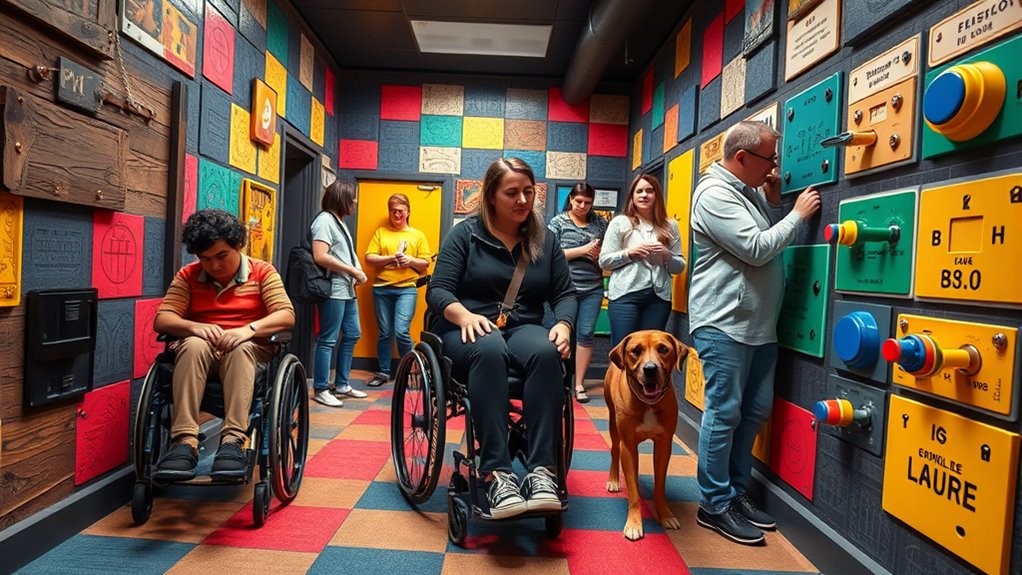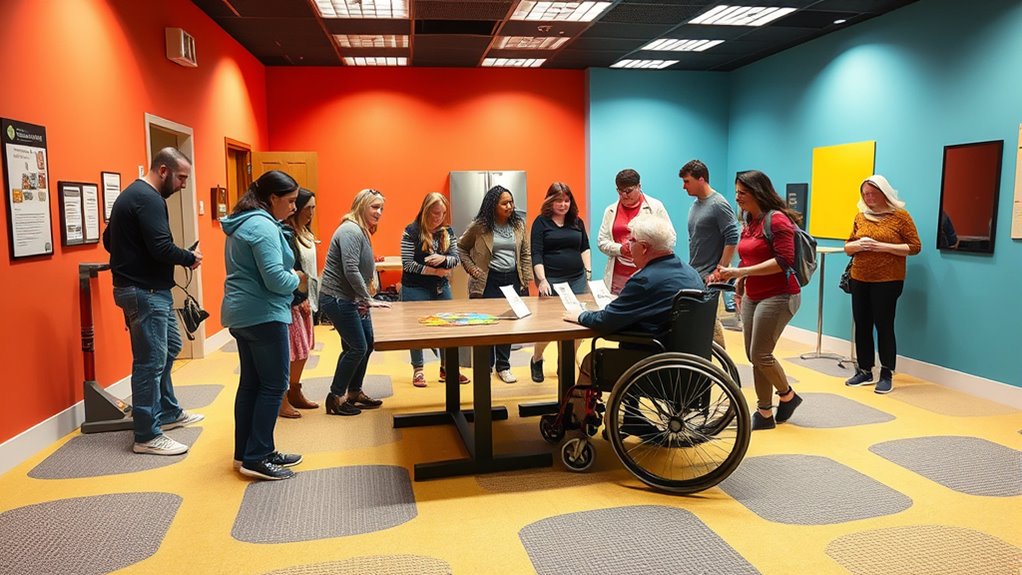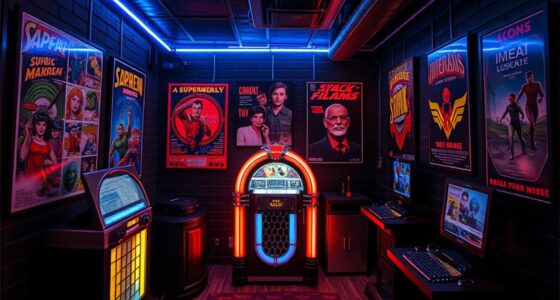Designing accessible escape rooms means creating spaces where everyone can participate fully, no matter their abilities. Use adjustable lighting, quiet zones, and sensory-friendly materials to accommodate sensory sensitivities. Incorporate adaptive technology like touchscreen interfaces or voice commands for diverse needs. Ensure room layouts have wide pathways and reachable clues for mobility challenges. Clear instructions in multiple formats help all players understand and enjoy the experience. Exploring these strategies further will show how you can make your escape room truly inclusive.
Key Takeaways
- Incorporate sensory accommodations like adjustable lighting, quiet zones, and sensory-friendly materials to support players with sensory sensitivities.
- Design room layouts with wide pathways, reachable puzzles, and adjustable fixtures to assist players with mobility challenges.
- Use adaptive technologies such as touchscreen interfaces, voice commands, and alternative input devices to enhance accessibility.
- Provide instructions and clues in multiple formats, including visual, audio, and tactile, to cater to diverse communication needs.
- Train staff to recognize and assist various disabilities, ensuring inclusive, supportive, and seamless escape room experiences.

Escape rooms are thrilling adventures that challenge your problem-solving skills, but they can sometimes be inaccessible to players with disabilities. If you have a visual, auditory, or mobility impairment, traditional escape rooms might seem out of reach. That’s where thoughtful design and adaptive solutions come into play, guaranteeing everyone can enjoy the experience. Sensory accommodations are essential, especially for players with sensory processing differences or sensitivities. Bright flashing lights, loud sounds, or overwhelming smells can hinder participation. Thus, incorporating options like adjustable lighting, quiet zones, or sensory-friendly materials helps create a welcoming environment. For instance, offering headphones or visual cues can ease sensory overload, allowing players to engage without discomfort. Adaptive technology further enhances accessibility by providing tools that compensate for various disabilities. Touchscreen interfaces with adjustable text sizes or voice command systems can replace traditional puzzles that rely heavily on visual or manual dexterity. For players with mobility challenges, designing rooms with wide pathways, grab bars, and adjustable-height tables ensures they can navigate and interact comfortably. Incorporating adaptive technology isn’t just about compliance; it’s about recognizing that different players have different needs and providing solutions that empower everyone to participate equally. For example, using apps that translate clues into audio or visual formats makes puzzles more accessible. Incorporating alternative input methods, such as switches or eye-tracking devices, allows players with limited mobility to manipulate objects or communicate their solutions effectively. It’s also important to think about the placement of clues and puzzles, making sure they’re within reach and easy to read or activate. By integrating sensory accommodations and adaptive technology, escape room designers demonstrate a commitment to inclusivity. This not only broadens your potential audience but enriches the experience for all players, fostering a sense of community and shared achievement. Additionally, understanding the role of individual differences in accessibility helps tailor experiences that respect diverse needs. When creating an accessible escape room, communication is key. Clearly marking accessible routes, providing instructions in multiple formats, and training staff to assist with diverse needs all contribute to a seamless experience. Ultimately, accessibility in escape rooms isn’t just about adding ramps or captions; it’s about designing environments that recognize and respect individual differences. By thoughtfully implementing sensory accommodations and adaptive technology, you guarantee that everyone, regardless of ability, can enjoy the challenge, excitement, and camaraderie that escape rooms offer.
Frequently Asked Questions
How Can Escape Rooms Accommodate Guests With Sensory Processing Disorders?
You can accommodate guests with sensory processing disorders by creating sensory-friendly environments and incorporating adaptive game features. Use soft lighting, reduce loud noises, and provide quiet spaces to ease sensory overload. Offer adjustable elements like tactile clues or visual aids, and allow guests to customize their experience. These thoughtful modifications help guarantee everyone enjoys the escape room without feeling overwhelmed, making the experience inclusive and fun for all abilities.
What Are Cost-Effective Accessibility Modifications for Small Escape Room Businesses?
You can implement budget modifications like replacing expensive equipment with cost-effective alternatives, adding clear signage, and reducing sensory triggers. Partner with local community organizations to access resources, funding, or volunteer support that can help improve accessibility without overspending. These strategies allow you to create an inclusive experience for all guests while keeping costs manageable. Building community partnerships also raises awareness and demonstrates your commitment to accessibility.
How Do You Train Staff to Assist Differently-Abled Participants Effectively?
You train your staff by providing extensive staff training focused on assistive techniques and effective communication. Role-play scenarios help staff practice assisting differently-abled participants confidently. Encourage your team to ask respectful questions and listen actively. Regularly update training to include new accessibility practices. By fostering awareness and empathy, your staff will learn how to support all participants effectively, ensuring everyone has an enjoyable, inclusive escape room experience.
Are There Legal Requirements for Accessibility in Escape Room Design?
Think of accessibility standards as the keys to open every door for all players. You must meet legal compliance by following specific regulations that guarantee your escape room is accessible to everyone. These standards often include features like ramps, tactile indicators, and clear signage. Ignoring them risks legal issues and excludes potential participants. So, prioritize accessibility standards to create an inclusive experience that welcomes all, regardless of ability.
How Can Virtual or Digital Escape Rooms Enhance Accessibility for All Players?
Virtual escape rooms can markedly enhance accessibility by allowing you to customize the experience. You can tailor challenges to different abilities and incorporate accessibility tools like screen readers, subtitles, and adjustable text sizes. These features let all players participate fully, regardless of physical or sensory limitations. By leveraging virtual customization and accessibility tools, you create an inclusive environment where everyone can enjoy the puzzle-solving fun.
Conclusion
By embracing inclusive design, you make escape rooms exciting and accessible for everyone. When you prioritize patience, positioning, and personalized options, you create a space where all participants feel confident and comfortable. Remember, accessibility isn’t just an add-on—it’s an essential element that elevates every experience. So, step up, stay sensitive, and endeavor to craft captivating, creative challenges that cater to all abilities, making every escape an equal adventure for everyone involved.









